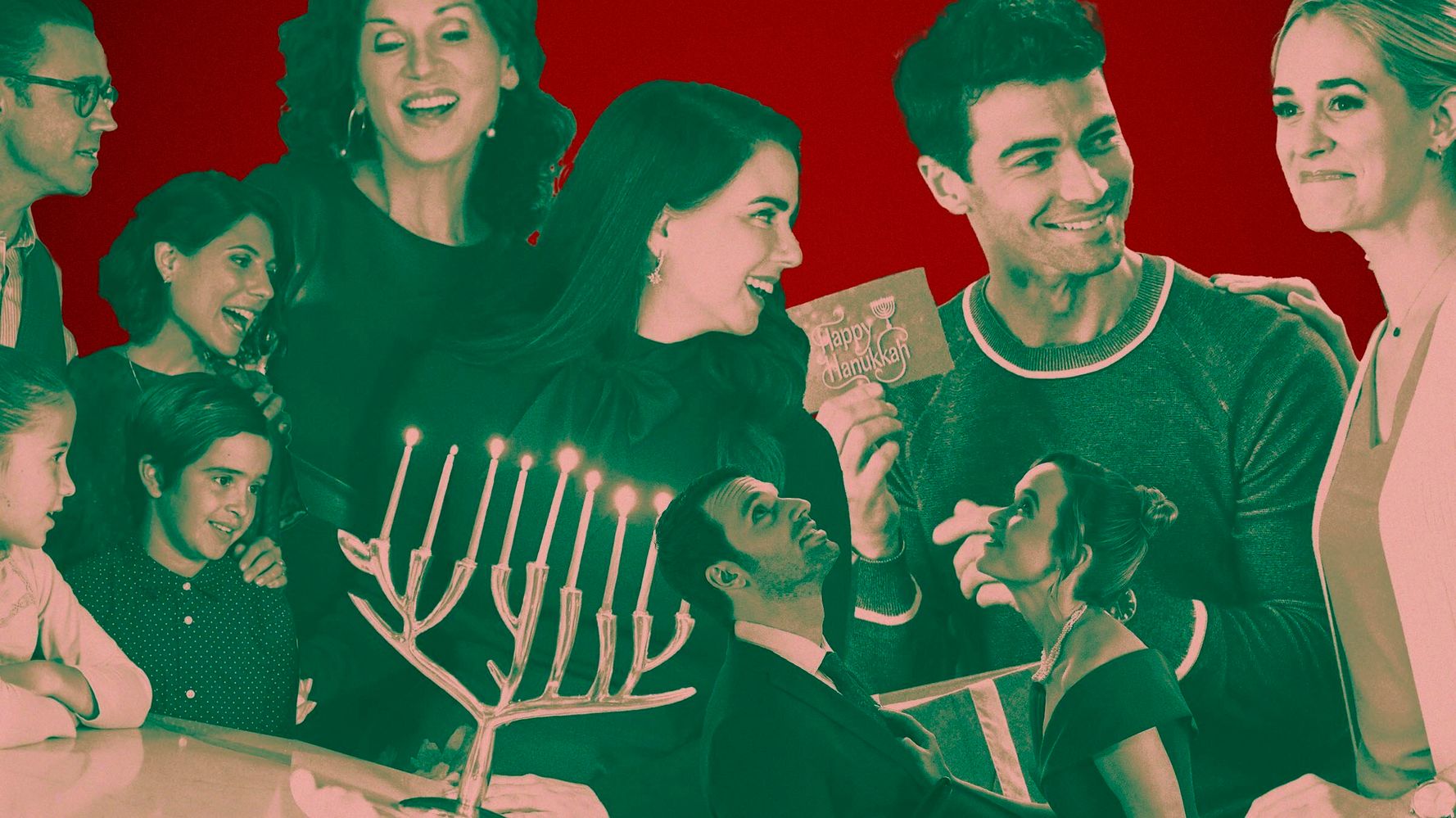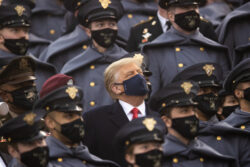It starts out like so many prototypical made-for-television Christmas movies do: with a beautiful woman in a tailored, red peacoat.
She walks into a store bedazzled in Christmas cheer. Her eyes open widely in joy as she purchases not one, not two, not three, but FOUR holly-covered wreaths. It’s the one she likes, the one she always buys for the windows of her Italian restaurant in Cleveland. This is, as she explains to a colleague who walks into a low-key culinary Santa’s workshop outpost, her first Christmas without her mother. Decorating with an abundance of tinsel garlands is just how she cheers herself up.
A discerning viewer might assume they know where this is going. She’ll meet a man who has not yet accepted the Christmas spirit into his heart, perhaps in a town in rural Ohio. They will face off, then connect. They’ll kiss under the mistletoe. She’ll find the family comfort she lost with her mother with this new love interest, and it will all be because of Christmas.
But about seven minutes in, this particular Hallmark film takes a left turn. You see, our fair Christmas heroine, Christina, was adopted. And after her adoptive mother died, she sent her DNA off to a 23andMe dupe to learn more about her biological roots. The computer pings, she opens her email and — surprise! — Christmas-obsessed Christina learns that she is 50% European Jewish. This is where the Hanukkah portion of “Love, Lights, Hanukkah!” which premiered on the Hallmark Channel earlier this month, comes in.
“Love, Lights, Hanukkah!” joins a smattering of other Jewish-themed Christmas movies, three of which came out in 2019: “Double Holiday” and “Holiday Date,” both Hallmark offerings, and “Mistletoe and Menorahs,” which aired last year on Lifetime. These movies all take on the curious challenge of integrating Judaism and Jewish people into the hyperspecific genre of made-for-TV holiday (read: Christmas) movies, and do so with varying degrees of sensitivity and success. (“Holiday Date” specifically fueled a good deal of backlash in 2019.)
Ultimately, the trend is an assimilationist project which tests the meaning of the increasingly buzzword-y, amorphous concepts of “diversity” and “inclusion.” Do Jews really want or need to see themselves in Christmas Movie World? And who are these movies really for — Jewish viewers or a Christian audience looking to be comforted by the idea that Jewish Americans really aren’t so different from them after all? The answers are complicated.
Hallmark and Lifetime’s Jewish Christmas movies share three major defining features, all of which speak to the ideology guiding these movies:
1. A central character who is an outsider to Judaism. In “Mistletoe and Menorahs” and “Holiday Date,” blonde shiksas who are thrown together by circumstance with Nice Jewish Boys — who are equally ignorant about Christmas — fill the “outsider” role. In “Double Holiday,” the outsider is the Jewish female lead’s Christian work rival. In “Love, Lights, Hanukkah!” arguably the most deft of the four, despite its inherently problematic-sounding genetics-based premise, Christina is both outsider and insider, learning about Judaism because she is personally invested in doing so.
2. An outsize focus on Hanukkah as a Christmas equivalent. Never have I ever seen so many dreidel decorations, and blue string lights, and blue and white ornament-covered wreaths!
3. The suggestion that love can triumph over any cultural or religious differences. The only one of the four movies I watched that technically features two Jews falling in love is “Love, Lights, Hanukkah!” and as previously mentioned, Christina only learns that she has Jewish heritage and family members at the beginning of the movie.
“Depictions of Jews in American popular culture are often categorized by whether they emphasize universality (we’re just like you!) or particularity (we have unique experiences!),” Grace Overbeke, an assistant professor of comedy studies at Columbia College, told HuffPost. If these are the two poles, Hallmark and Lifetime Jewish Christmas movies fall decidedly into the universality camp.
These Jewish Christmas movies also fit into a long tradition of Jews being present, albeit often subtly, in Christmas-focused pop culture. All four of Lifetime and Hallmark’s Jewish Christmas movies appear to have been written by Jewish screenwriters, and Jewish actors like Mia Kirshner, Ben Savage, Jake Epstein and Matt Cohen star in them.
“There has been a Jewish presence and sensibility in Christmas entertainment going back close to a century,” said Henry Bial, a professor of theater at the University of Kansas and author of “Acting Jewish: Negotiating Ethnicity on the American Stage and Screen.”
He cited the classic 1954 Christmas film “White Christmas,” which was based around a song written by Irving Berlin, a Jewish composer, and starred Danny Kaye, a Jewish actor. “Rudolph the Red-Nosed Reindeer”? Also created by a Jew.
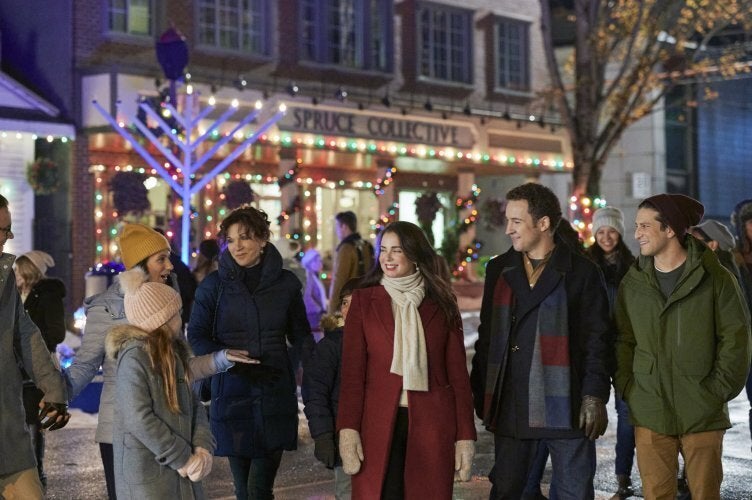
In America, Christmas has become less of a religious holiday than a stand-in for an entire season of hyperconsumerism. This allows made-for-TV Christmas movies to focus on the holiday without really focusing on religion or Jesus. Religiously, Hanukkah is a far less important holiday than Christmas. But because of its proximity on the calendar to Christmas, it became more of a focal point for American Jews.
“Historically, part of becoming ‘American’ meant that Jews had to give our religion a bit of a makeover so that it would resemble Protestant worship — to be more legible as a ‘religion’ deserving of the American ideal of religious freedom,” Overbeke told HuffPost. Thus “Judaism became ‘rebranded’ in some ways as another version of Christianity. Synagogue became reimagined as a Jewish version of church; Hanukkah became the Jewish version of Christmas.”
In other words, Hanukkah became a vehicle for American Jewish assimilation. (In a twist of irony, the story of Hanukkah centers on the Maccabees, a Jewish tribe who were, as Overbeke put it, “militantly opposed to assimilation.”)
Given this very American reality, it is wholly unsurprising that Christmas movies trying to integrate Jewish themes and characters into the holiday spirit would end up relying on Hanukkah as a touchpoint.
After all, pop culture can be a powerful tool of cultural absorption, something that many Jewish-American immigrants have historically desperately desired. Overbeke pointed to turn of the 20th century “assimilationist romances,” like the Israel Zangwill play “The Melting Pot” (1908) and Anne Nichols’ play-turned movie “Abie’s Irish Rose” (1922), both of which focus on Jewish men who fall in love with non-Jewish women. And in both plays, the couples’ interfaith love serves as a vehicle for the melting away of ethnic bigotry. Hallmark and Lifetime’s TV movies can be seen as the lowbrow thematic descendants of these plays. None of the movies explicitly address bigotry, but they do use love as a vehicle for collapsing difference and doing away with ignorance.
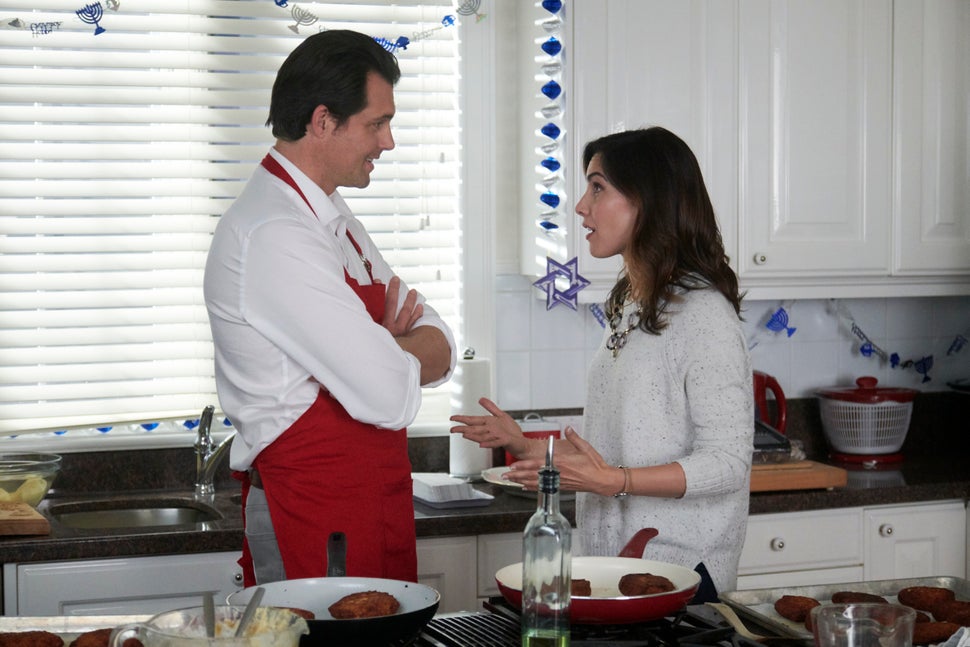
All of the Jewish Christmas movies in the Lifetime/Hallmark universe contain an element of inviting in through cultural exchange. Christina’s newly discovered family members teach her about the Jewish foods, like latkes, they serve at the deli they own, and in “Mistletoe and Menorahs,” Jonathan (the Jew) teaches Brooke (the Christian) about Hanukkah so that she can be culturally competent enough to land a big account from a Jewish client. In turn, Brooke helps Jonathan learn about Christmas to impress his girlfriend’s Christian father, and Christina invites her family to her restaurant’s big Feast of the Seven Fishes dinner on Christmas Eve.
At times, the idea that the Jewish characters are so ignorant about certain Christmas traditions — Rebecca (“Double Holiday”) and Jonathan (“Mistletoe and Menorahs”) are both flummoxed by Christmas decorations, Joel (“Holiday Date”) has no idea what the words are to “Deck The Halls” — strains credulity. Whereas it is completely believable to me, a Jew who grew up around a whole lot of Catholics, that many Christian families might not even know what a menorah is, the vast majority of American Jews learn about Christmas songs and decor and traditions by osmosis. Christmas is everywhere. Hanukkah is not. Christian ignorance of Judaism exists, quite simply, because it easily can. And to pretend that this ignorance cuts equally both ways, as several of these movies suggest, is to ignore the reality that Jews continue to be othered in this country in a way that Christians do not.
“I think that often, particularly with Hanukkah, there is an attempt to use it as an occasion to say, ’We’re not really so different, me and you,’” Bial told HuffPost. “And that is in some ways a lovely sentiment, and in other ways, I could see why some Jews would push back and say, ‘Actually, we are different.’”
All four movies still adopt the unmistakable made-for-TV holiday movie aesthetic. Christmas decorations abound, and when we get a peek inside Jewish homes, the featured Jews simply swap multicolored string lights for white twinkly ones, and red and green wreaths for blue and white wreaths. (In a particularly egregious visual, Christina’s birth family’s Jewish home in “Love, Lights, Hanukkah!” is draped in many green boughs.)
Assimilation and the blending of faiths are also present in the costuming. “Double Holiday” follows Rebecca (the Jew) and Chris (the Christian), work colleagues who have to plan their company’s Christmas party as they are competing for a promotion, and the planning process happens to intersect with Hanukkah celebrations. When the movie begins, Rebecca can often be found wearing a blue button-up or a blue apron. Chris wears green sweaters and a red apron. As Chris learns more about Hanukkah, and as he and Rebecca grow closer, their wardrobes get a switch-up: Chris ends up in blue and Rebecca in red. At the very end, they both wear blue to the Christmas party, but Chris doesn’t forget his red pocket square. (As if a Hallmark film would ever deal in subtlety.)
Perhaps this is why some critics bristled last year at the promise of Hanukkah movies only to be served up stories in which “Hanukkah and the characters who celebrate it exist only in relation to Christmas,” as Nancy Coleman wrote in The New York Times. “Holiday Date,” which features Jewish actor Joel accompanying blonde Brooke home for Christmas to pretend to be her very Christian boyfriend even elicited some cries of anti-Semitism for its use of the “trope of the sneaky, untrustworthy Jew,” as Britni de la Cretaz wrote in The Washington Post. (“He seems nice enough, but there’s just something that just isn’t right,” Brooke’s father says at one point in the film. “He’s a bit of an odd duck.”)
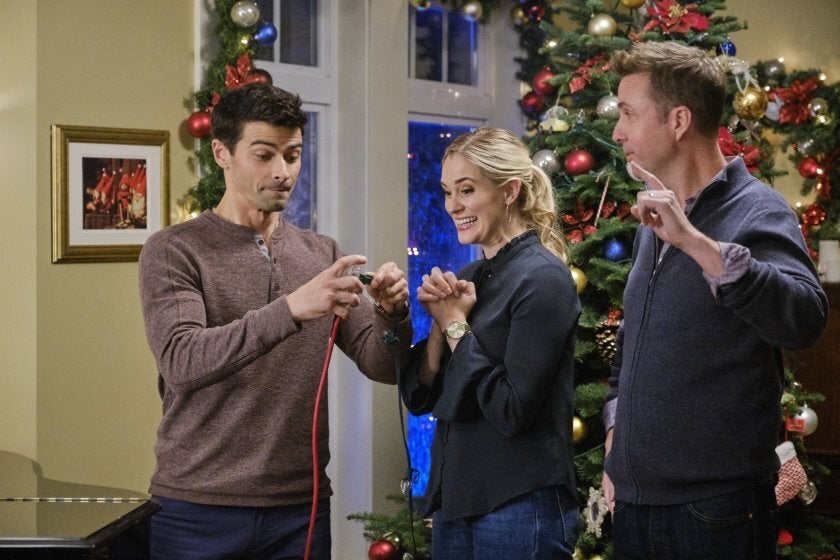
When I first heard about “Love, Lights, Hanukkah!” I was sure that it would be worse than any of its predecessors. (Jews are apt to bristle at any mention of genetically identifying and sorting us.) But oddly enough, it was an improvement. Instead of centering so much around Christmas or a Christian family, the vast majority of characters — including the Christian Outsider lead — are, in fact, Jewish. They may do things like throw the phrase “shayna punim” out in casual conversation and obsessively collect dreidels, but at least the exploration of Judaism at the center of the story does not hinge on a deception or a desperation to get ahead at work. Instead, it’s about Christina’s personal exploration of faith and heritage.
Bial sees movies like “Double Holiday,” “Mistletoe and Menorahs,” “Love, Lights, Hanukkah!” and even the much-maligned “Holiday Date,” as relatively harmless, if not outright positive. If viewers are frustrated with an oversimplification of Jewish tradition depicted in Hallmark and Lifetime offerings, perhaps it’s the form itself — mass-produced, simplistic holiday fairy tales — which must bear the blame.
“Generally speaking, inclusion is a good thing,” he said. “There is a value for Jews in seeing ourselves included, [seeing] that we have a place in some of these stories.”
Towards the end of “Double Holiday,” one character states: “We may celebrate differently, but we’re all in this together.” What “this” is — The holiday season? The hellscape of American late-stage capitalism? — remains a mystery, but at least we can rest assured that it is a shared experience.
As Bial remarked: “Why miss an opportunity to sell Hanukkah cards as long as we are selling Christmas cards?”
Calling all HuffPost superfans!
Sign up for membership to become a founding member and help shape HuffPost’s next chapter
